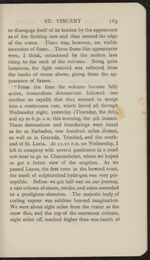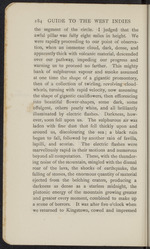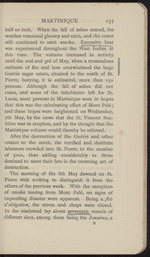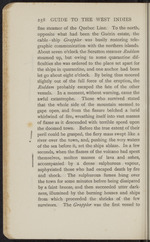| 1 |
 |
“...lives, was given by the
Rev. J. H. Darrell of Kingstown, who was an
eye-witness of this appalling event:—
“At 7 a.m. on Wednesday, the 7th instant,
there was another sudden and violent escape of
pent-up steam, which continued ascending till
10 a.m., when other material began to be ejected.
It would seem that this was the time when the
enormous mass of water in the lake of the old
crater was emitted in gaseous condition. . . . The
mountain heaved and laboured to rid itself of the
burning mass of lava heaving and tossing below.
By 12.30 p.m. it was evident that it had begun...”
|
|
| 2 |
 |
“...ST. VINCENT
i»3
to disengage itself of its burden by the appearance
as of fire flashing now and then around the edge
of the crater. There was, however, no visible
ascension of flame. These flame-like appearances
were, I think, occasioned by the molten lava
rising to the neck of the volcano. Being quite
luminous, the light emitted was reflected from
the banks of steam above, giving them the ap-
pearance of flames.
“From the time the volcano became fully
active, tremendous detonations followed one
another so rapidly that they seemed to merge
into a continuous roar, which lasted all through
Wednesday night, yesterday (Thursday, the 8th),
and up to 6.30 a.m. this morning, the 9th instant.
These detonations and thunderings were heard
as far as Barbados, one hundred miles distant,
as well as in Grenada, Trinidad, and the south-
end of St. Lucia. At 12.10 p.m. on Wednesday, I
left in company with several gentlemen in a small
row-boat to go to Chateaubelair, where we hoped
to get a better view...”
|
|
| 3 |
 |
“...effulgent, others pearly white, and all brilliantly
illuminated by electric flashes. Darkness, how-
ever, soon fell upon us. The sulphurous air was
laden with fine dust that fell thickly upon and
around us, discolouring the sea; a black rain
began to fall, followed by another rain of favilla,
lapilli, and scoriae. The electric flashes were
marvellously rapid in their motions and numerous
beyond all computation. These, with the thunder-
ing noise of the mountain, mingled with the dismal
roar of the lava, the shocks of earthquake, the
falling of stones, the enormous quantity of material
ejected from the belching craters, producing a
darkness as dense as a starless midnight, the
plutonic energy of the mountain growing greater
and greater every moment, combined to make up
a scene of horrors. It was after five o’clock when
we returned to Kingstown, cowed and impressed...”
|
|
| 4 |
 |
“...NEVIS
225
some local importance, and a few miles farther
on the Elack Rocks are reached. These consist
of huge masses of lava standing out in the sea,
against which the deep blue water dashes itself
into white foam. Proceeding round the island,
Sandy Point and Brimstone Hill are passed in suc-
cession. The next place which deserves a visit
is Middle Island Church, which shelters the tomb
of Sir Thomas Warner, the founder of the colony.
This great coloniser died at St. Kitts on the 10th
of March 1648, universally respected. His tomb
is inscribed:
“ First read, then weepe when thou art hereby taught,
That Warner lies interr’d here, one that bought,
With losse of noble blood, illustrious name
Of a Commander greate in Acts of Fame.”
The church is the parish church of Old Road, a
place which derives its name from the involuntary
exclamation of Columbus upon his second visit to
St. Kitts, “ Ah 1 we are at the old road again.”
NEVIS
Nelson's Island
The island of Nevis (Nievis, or Mevis, as it...”
|
|
| 5 |
 |
“...MARTINIQUE 257
half an inch. When the fall of ashes ceased, the
weather remained gloomy and calm, and the crater
still continued to emit smoke. Excessive heat
was experienced throughout the West Indies at
this time. The volcano increased in activity
until the 2nd and 3rd of May, when a tremendous
outburst of fire and lava overwhelmed the large
Guérin sugar estate, situated to the north of St.
Pierre, burying, it is estimated, more than 150
persons. Although the fall of ashes did not
cease, and some of the inhabitants left for St.
Lucia, most persons in Martinique were in hopes
that this was the culminating effort of Mont Pelé;
and these hopes were heightened on Wednesday,
7th May, by the news that the St. Vincent Sou-
frière was in eruption, and by the thought that the
Martinique volcano would thereby be relieved.
After the destruction of the Guérin and other
estates to the north, the terrified and destitute
labourers crowded into St. Pierre, to the number
of 5000, thus adding considerably...”
|
|
| 6 |
 |
“...survived stated
that the whole side of the mountain seemed to
gape open, and from the fissure belched a lurid
whirlwind of fire, wreathing itself into vast masses
of flame as it descended with terrible speed upon
the doomed town. Before the true extent of their
peril could be grasped, the fiery mass swept like a
« river over the town, and, pushing the very waters
of the sea before it, set the ships ablaze. In a few
seconds, when the flames of the volcano had spent
I themselves, molten masses of lava and ashes,
accompanied by a dense sulphurous vapour,
asphyxiated those who had escaped death by fire
and shock. The sulphurous fumes hung over
the town for some minutes before being dissipated
by a faint breeze, and then succeeded utter dark-
ness, illumined by the burning houses and ships
from which proceeded the shrieks of the few
survivors. The Grappler was the first vessel to...”
|
|
| 7 |
 |
“...MARTINIQUE 259
catch fire, and was soon seen to turn over and dis-
appear, capsized probably by a sort of tidal wave
caused by the force of the explosion. Some of
those down in the hold and in the forepart of the
Roraima managed to escape, but the steamer was
burned to a mere shell. The Roddam alone
escaped. Soon after her anchoring in the quar-
antine grounds the eruption took place, and im-
mediately afterwards molten lava fell on the ship.
In a few minutes a second explosion took place,
causing the sea to become a raging caldron, and
this appears to have parted her anchor and caused
her to drift. On board were fifteen labourers from
Grenada looking after the cargo, seven of whom
were roasted alive on the deck, while eight jumped
overboard. The chief engineer, the first and
second officers, and the supercargo lost their
lives. Of the forty persons who left St. Lucia,
only ten or twelve returned alive after taking nine
hours to steam forty miles. Severely burned on
his hands and face,...”
|
|
